Located in the northeast of Victoria, Yackandandah is 288 km north-east of
Melbourne and 22km from the historic town of
Beechworth, set amidst hills. The Aboriginal name of the town is said to mean "rock" and "water-hole" and conveys that long ago,
two rocks sat one on top of the other in Yackandandah Creek.
The town centre of Yackandandah has well-preserved buildings from the town's gold-mining heyday, which are classified by the National Trust.
The Dhudhuroa People
The Dhudhuroa people occupied areas of northeast Victoria for thousands of years. However, after colonisation,
many experienced dispossession and succumbed to diseases for which they had no immunity.
As
hunter and gathers, the Dhudhuroa people moved about according to the seasons and food sources. During the summer months, they would move to the higher, cooler regions, building bark shelters
near the rivers and wetlands. In the winter, they would wear possum-skin cloaks for warmth. These cloaks were also used to carry infants,
in ceremonies and for burials. About 40-70 possum skins were required for an adult-sized cloak.
 |
| Aboriginal women of Victoria, Australia, circa 1900 |
About 20 km south of Yackandandah, at the top of Mt Pilot, there are Aboriginal spiritual and
ceremonial sites and red-ochre rock art. A painting of a thylacine (Tasmania tiger), a Goanna and a Snake, which are the clans' totem spirits, can be found in a rock shelter and is dated at over two thousand years old.
 |
| Thylacine rock painting at Yeddonba Aboriginal art walk at Mt Pilot, Victoria |
The Europeans
Hamilton Hume and William Hovell passed close to present-day Yackandandah in 1824, on route to the Port Phillip District, during an important journey of exploration and camped on Yackandandah Creek, near the junction with the Kiewa River (
east of the townsite). Positive reports from the explorers led to the arrival of settlers in the Yackandandah district in the 1830s and the beginning of pastoralism. The name of the settlement, Yackandandah, comes from the Yackandandah run, which belonged to James Osborne.
David Reid was the son of a Royal Naval surgeon, who was born in England. At the end of 1843, he took up land near Yackandandah and in 1845, he built the first water-driven flour-mill in the district, on his Yackandandah run. Supposedly, a worker called Beaton who was building the mill found gold in 1845, but Reid
didn't believe that gold could be found in Australia. He said:
There is no gold in the Colony or this part of the world. This is only mica, if you want gold you will have to go the Ural Mountains in Russia. How wrong he was.
James Obsorne who was born in Ireland in 1793, was one of the first settler farmers in the Yackandandah district. On one occasion, when a notorious gang of bushrangers led by Black Douglas held up the Yackandandah run, James Osborne threw his money out the window into the chook house to hide it. Later, when gold was found near the Yackandandah Creek in 1852, Osborne began buying gold, but he did not allow anyone to dig on his land. After his death, mining did commence and alluvial gold was found in his vegetable garden.
William Bowman
took up land in the district called "Tarrawingee" and Joseph Slack took up "Barnawartha".
 |
| Yackandandah, VIC, Leader (Melbourne, Vic. : 1862 - 1918, 1935), Saturday 2 July 1898 |
A poem was published in the Melbourne Punch, 11 June 1857, titled, “The Lass of Yackandandah”. Here is the first stanza. The rest of the poem
here
“ Let poets sing of English girls,
Their beauty and their candour;
Give me a sweeter nymph than all, –
The lass of Yackandandah."
"She draws a cork with such an air,
No mortal can withstand her;
She turns a tap, and turns our heads, –
The lass of Yackandandah. ”
— O'Brien, The Lass of Yackandandah – a goldfield beauty
Gold
Finding gold at Yackandandah Creek in December 1852 caused many hopeful prospectors to arrive and soon, tents and timber buildings
were proliferating. Many of these miners came to Yackandandah from the goldfields of North America. This was the start of the Yackandandah village. Mining continued at Whisky Flat, Kirby’s Flat, Osborne’s Flat and Doctor’s Flat and the town’s population ballooned to 3000.
The first miners worked mostly on their own, with their own tools, but towards the end of the 1850s deep mining was underway.
 |
| Working Hydraulics on Mr John Wallace's Claim at Kowdy Flat, Yackandandah. Australasian (Melbourne, Vic. : 1864 - 1946), Saturday 14 July 1894 |
During the gold era at Yackandandah, Aboriginal people would show off their boomerang abilities and miners would give them money for these demonstrations. Many
miners were impressed with the Aboriginals' ability to "hit a penny piece 50 yards off" and how their boomerangs moved at "the speed of lightning and if aimed true, hitting its victim with an irresistible force" (Black Gold: Aboriginal People on the Goldfields of Victoria, 1850-1870, By Fred Cahir).
 |
| Age (Melbourne, Vic. : 1854 - 1954), Monday 23 May 1938 |
Gold in the town required the presence of police, so a camp was established at Reid's Mill in 1853 and
a courthouse was built at Yackandandah in 1855. Three grog shanties were soon in evidence and the first store was set up by Dr Holman.
The Holy Trinity Church of England was built in Yackandandah of granite quarried from Commissioner's Creek in 1860.
 |
| Exterior view of wooden single storey flour mill with shingled roof. The building was constructed by David Reid, the second occupant of the Yackandandah No. 2 run, in 1845-1846. It shut down after silt from mining operations interfered with the working of the mill. State Library of VIC |
A survey of Yackandandah was made in 1856 and land sales commenced in early 1857.
 |
| Yackandandah Times (Vic. : 1890 - 1931), Friday 30 July 1897 |
The stone bridge over Commissioners Creek on the Wodonga road was built in 1859. The bridge was part of a proposed main road between Sydney and Melbourne. The plan changed, however, when the Beechworth Hills were considered and the road was built
on flatter country to the west.
Yackandandah's Post Office was built in 1862.
 |
| The Bridge over Commissioner's Creek is a single arched bridge which was constructed c. 1857. Weekly Times (Melbourne, Vic. : 1869 - 1954), Saturday 21 April 1906 |
Notorious Bushranger
Dan Morgan, later known as the bushranger Mad Dog Morgan grew up in Campbelltown, NSW. He tried his hand at prospecting gold in Victoria in 1853 and began his bushranger career, in the following year, when he held up a shepherd near Castlemaine. Later, after being confined in Castlemaine Gaol and escaping and being caught again, Morgan was sentenced to 12 years hard labour and imprisoned on floating prison ships by the Victorian authorities.
Morgan served only 6 years and was conditionally released on 23 June 1860 with the proviso that he remained in the vicinity of the Ovens and Yackandandah police. On 19 July 1860, it was reported that Morgan was "illegally at large".
 |
| "Morgan sticking up the navvies, burning their tents, and shooting the chinaman.", January 25, 1865. State Library of VIC |
Snake Bite Cure?
Prussian born Dr Augustus Mueller,
vigneron of Yackandandah, promoted injections of strychnine as a cure for snake bites. Queen Victoria was so impressed by the idea that she demanded a trial of the treatment. Fortunately, a scientifically based antidote was found.
 |
| Yackandandah Times (Vic. : 1890 - 1931), Saturday 24 January 1891 |
 |
| Vineyards, Yackandandah, VIC, Weekly Times (Melbourne, Vic. : 1869 - 1954), Saturday 21 April 1906 |
Dr Mueller also ran a winery in Yackandandah at "Melville House" built c.1863.
 |
| The “Cottage Hospital” which was located on the corner of High Street and Bells Flat Road, Yackandandah, opened on June 8, 1903 and closed when the new Hospital was established in 1931 |
At Yackandandah, Dr Mueller was providing services as a general practitioner in 1862 or 1863.
On The Road
Royal Mail Coaches travelled to and from Yackandandah and to other towns, including Beechworth. Before the rail line was built,
the main coach road from Sydney to Melbourne went through Yackandandah.
|
|
Yackandandah Times (Vic. : 1890 - 1931), Thursday 29 June 1911
|
Work
John Hattersley, who was born on the Isle of Man, was listed as a ginger beer manufacturer in Woolshed in the Ovens Directory from 1857. John Hattersley's cordial and soda water factory at 27 Windham Street Yackandandah operated until at least 1930.
 |
| Hattersley's Soda Water, Yackandandah. Troedel & Co. (lithographer.) [ca. 1873-ca. 1879] |
 |
| Zwar Brothers tannery, Yackandandah, Vic, Leader (Melbourne, Vic. : 1862 - 1918, 1935), Saturday 2 July 1898 |
John Haig established a Grocery store at Yackandandah in 1864 and lived at Twists Creek Road with his family at "Bemersyde".
Chinese, market Gardners sold fresh vegetables that they grew along the flats of local creeks and rivers, at Yackandandah.
Play
 |
| Yackandandah Times (Vic. : 1890 - 1931), Friday 19 April 1895 |
The Yackandandah Roads District was proclaimed in August 1862, a council area which was one of the largest areas in the Colony.
In July 1891, Yackandandah was connected to Beechworth by rail, officially opened by the Postmaster-General, John Duffy.
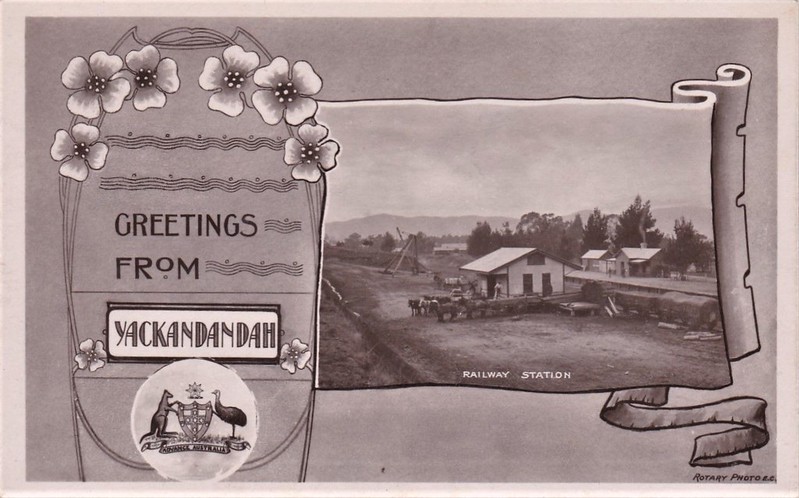 |
| Railway Station, Yackandandah, Victoria, early 1900s |
Mining Changes
As alluvial gold became scarcer, reef mining was instigated about 1860. Then in the 1890s, mining with barges and dredges. However, what didn't change was that miners worked very hard, under often unsafe conditions, often, seven days a week. Consequently, there was a fairly high death rate. In August 1901, Patrick Gavin collapsed and died while fixing a pump and the "Yackandandah Times" called for police to prosecute the manager for making the miners work on Sundays. (Ian Touzel's "Gold and Gumboots").
 |
| Dredge at Staghorn, Weekly Times (Melbourne, Vic. : 1869 - 1954), Saturday 21 April 1906 |
Both farming and mining were important to the economy of Yackandandah, but mining became less significant by the beginning of WWI.
Famous Sons
 |
| Yackandandah School - Yackandandah, VIC, circa 1879. State Library of NSW |
Yackandandah Primary School originally commenced as a Church of England school in 1855, taken over by the Victorian Government in 1874. Before the school existed, this land was used as the local cemetery.
The first pupil listed on the register of the state school was Isaac Isaacs, aged 8. He went on to become the first Australian born Governor-General of Australia.
As a child,
Isaac Isaacs wandered about the goldfields at Yackandandah and he learnt quite a bit of Chinese from the Chinese miners who were there at the time. He would go on to be proficient in other languages.
Church of England missionaries would also visit the Chinese miners at Yackandandah and Beechworth. When asked about the idols that they prayed to, the Chinese replied that, "Our gods has protect us to get plenty of gold". (Gold Seeking: Victoria and California in the 1850s, By David Goodman).
 |
| Sir Isaac Alfred Isaacs and his wife, Deborah 'Daisy' Jacobs, was the son of Alfred Isaacs, a tailor of Jewish ancestry from the town of Mława, Poland. He grew up in Yackandandah and Beechworth and served as the ninth Governor-General of Australia, in office from 1931 to 1936 |
William Tewksbury (1869-1953) was born at Yackandandah, the son of a gold miner; he was very interested in new technologies, from penny-farthing bicycles to cars, aeroplanes and film. He introduced Yellow Cabs to Australia, and in the same year (1922) he produced a version of Rolf Bolderwood’s ‘Robbery under Arms” in Australia.
1930s
 |
| Yackandanda from Myrtleford Road, Weekly Times (Melbourne, Vic. : 1869 - 1954), Saturday 6 December 1930 |
 |
| High Street, looking east, Yackandandah, VIC, circa 1930. Weekly Times (Melbourne, Vic. : 1869 - 1954), Saturday 6 December 1930 |
 |
| View from the aeroplane of picturesque Yackandandah, VIC, Weekly Times (Melbourne, Vic. : 1869 - 1954), Saturday 16 January 1932 |
 |
State Electricity Commission employes erecting large wooden poles with the
aid of this truck and a winch. It is hoped that Yackandandah will have
a supply of electricity before Christmas, Border Morning Mail (Albury, NSW : 1938 - 1943), Tuesday 14 November 1939 |
 |
| Border Morning Mail (Albury, NSW : 1938 - 1943), Wednesday 10 May 1939 |
1940s-50s
 |
| Advocate (Melbourne, Vic. : 1868 - 1954), Thursday 17 October 1940 |
 |
| Pte. J. Lorimcr (left) , of Yackan-dandah, at Heidelberg MilitaryHospital yesterday, showing Pte. R.Harris the steel helmet throughwhich an anti-tank bullet passedwhen he was taking part in an action on the Western Desert. Age (Melbourne, Vic. : 1854 - 1954), Tuesday 18 November 1941 |
 |
| Yackandandah, VIC, CWA Ciommittee, Weekly Times (Melbourne, Vic. : 1869 - 1954), Wednesday 21 September 1949 |
 |
| Yackandandah, VIC, Brass Band, Weekly Times (Melbourne, Vic. : 1869 - 1954), Wednesday 21 September 1949 |
 |
Cpl Graeme W. Baker and C L Max W. Baker, twin sons of Mr and Mrs
E. H. Baker. State Savings Bank. Yackandandah. who have been reported
prisoners of war in Japanese hands. Border Morning Mail (Albury, NSW : 1938 - 1943), Tuesday 2 November 1943 |
 |
| The Bush Nursing Hospital, Yackandandah, VIC, [c1920-1954]. State Library of VIC |
 |
| Bush Nursing Hospital Staff, Yackandandah, VIC, Weekly Times (Melbourne, Vic. : 1869 - 1954), Wednesday 8 July 1953 |
The 1947 Census showed that of the 683 private houses in Yackandandah Shire, almost half were without running water; just over a quarter had electricity; none had gas and almost all were without a flush toilet.
Between 1976 and 1992 Yackandandah's population grew 41.2 per cent. (Indigo Shire Heritage Study)
Today Yackandandah is a popular tourist destination, with its attractive historic village and delightful location, nestled in the foothills of Stanley State Forest.
Around Yackandandah
 |
| Built about 1865, Yackandandah , VIC |
 |
| Built for the Bank of Australasia, Yackandandah, VIC, with local granite, 1859 |
 |
| Shops built about 1865, Yackandandah, VIC |
 |
| Yackandandah Post Office the earliest public building, constructed in 1863 |
 |
The former Bridge Hotel Yackandandah (circa 1859), was at one time ownded by Mel Gibson or his ex w
ife Mattinbgn |
 |
| Yackandandah Motor Garage was built in the 1850's as a store for Samual Cunningham. Later converted to a carriage business for by Louis Meurant |
 |
| Formerly the Yackandandah Times Building, circa 1870, VIC |
.jpg) |
| Bank of Victoria, now Yackandandah Museum, construction commenced in 1860 |
 |
| W Roper purchased bought the land for S G Dean’s grocery and hardware store in 1857. Roper built this two storey shop and attached residence of local red bricks in about 1864-66 |
 |
| The Clarence Hotel, licensed in 1854 once stood here. This building was constructed in 1885, Yackandandah , VIC |
 |
| The former State Savings Bank, Yackandandah, circa 1929 |
 |
| High Street shop, Yackandandah, circa 1857 |
 |
| The Star Hotel was built by James Cardwell, 1863. However, an earlier Star Hotel on this site was operated by Mr John A Wallace, 1855 |
 |
| Formerly the pharmacy of Matthew Sharpe Rome, at 22 High Street. He was born in Scotland |
.jpg) |
| The Yackandandah Sanatorium was established at the corner of Kars and High Streets by Dr Mueller |
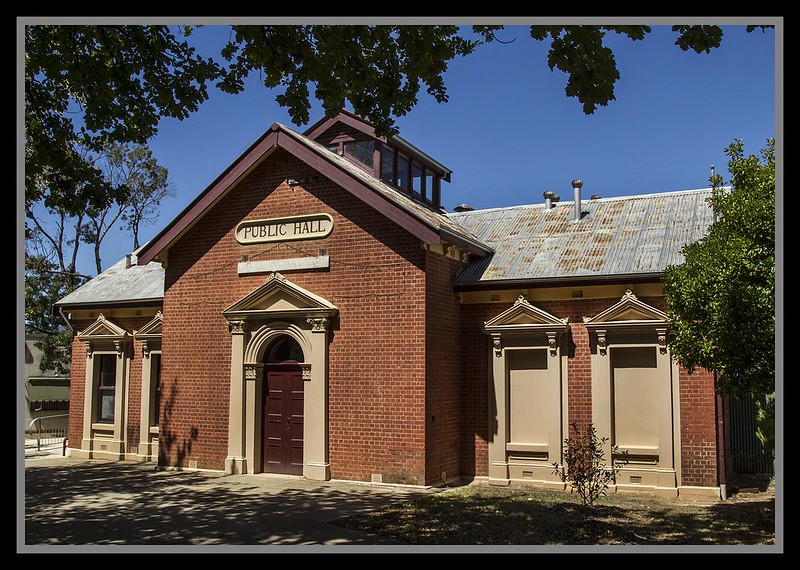 |
| Yackandandah Public Hall: 36 High Street, Yackandandah - next to Shire Offices, courthouse (1863) John |
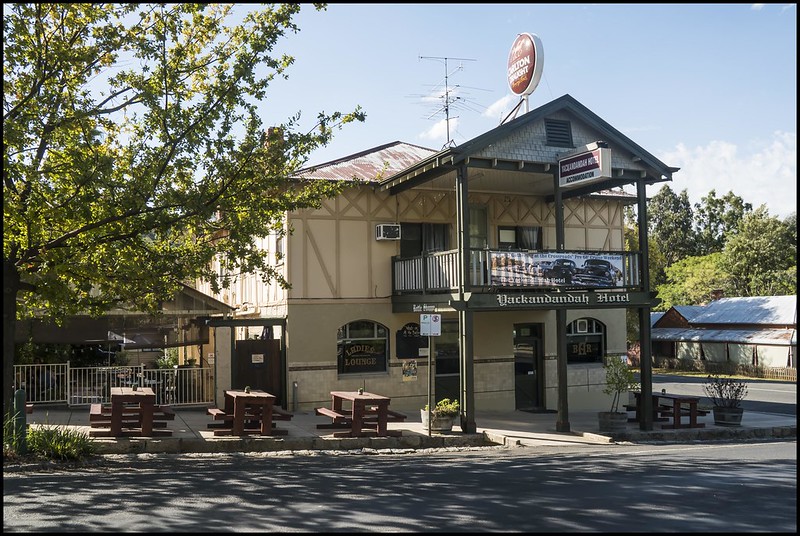 |
The Yackandandah Hotel (Bottom Pub), was originally a single story building. A billiard license was granted to he original Yackandandah Hotel in the name of John G. Fen-
nell, in 1855. John |
 |
| Ovens and Murray Advertiser (Beechworth, Vic. : 1855 - 1918), Saturday 20 January 1855 |
 |
| The “little dog-box” which served as Yackandandah’s Post and Telegraph Office was replaced during 1863 by the building which still stands today. Mattinbgn |
 |
| The Athenaeum, Yackandandah, a building used for intellectual and/or literary purpose. The Athenaeum housed 3000 books at one stage, circa 1878. The town's book club was established in 1867 |
 |
| A secret underground hut, near Yackandandah, was built illegally about 25 years ago by an unknown builder. The hut has rendered plaster walls, a bath and shelving. Read more |
 |
| Inside the underground hut near yackandandah, VIC |
 |
| yackandandah, Vic |
 |
| Bridge built in 1857. Constructed in rusticated ashlar stone using local honey coloured granite with the stringcourse and parapet cappings in a darker stone |
 |
| Yackandandah Creek, VIC |
.jpg) |
| Old farm shed near Yackandandah, VIC, John |
 |
| "Donated by Annis and George Bills, Australia". At Yackandandah, VIC. George Bills was born in Brighton in England in 1859 and he and his wife Annis had no children. Following the death of George in 1927 a trust fund was set up to build horse troughs for the relief of horses across the country |
 |
| St James Uniting Church, Yackandandah, VIC, erected in 1868, Mattinbgn |
 |
| Holy Trinity Anglican Church, Yackandandah VIC was erected in 1861 |
Things To Do and Places To Go
Gold Seeking: Victoria and California in the 1850s, by David Goodman































.jpg)






.jpg)



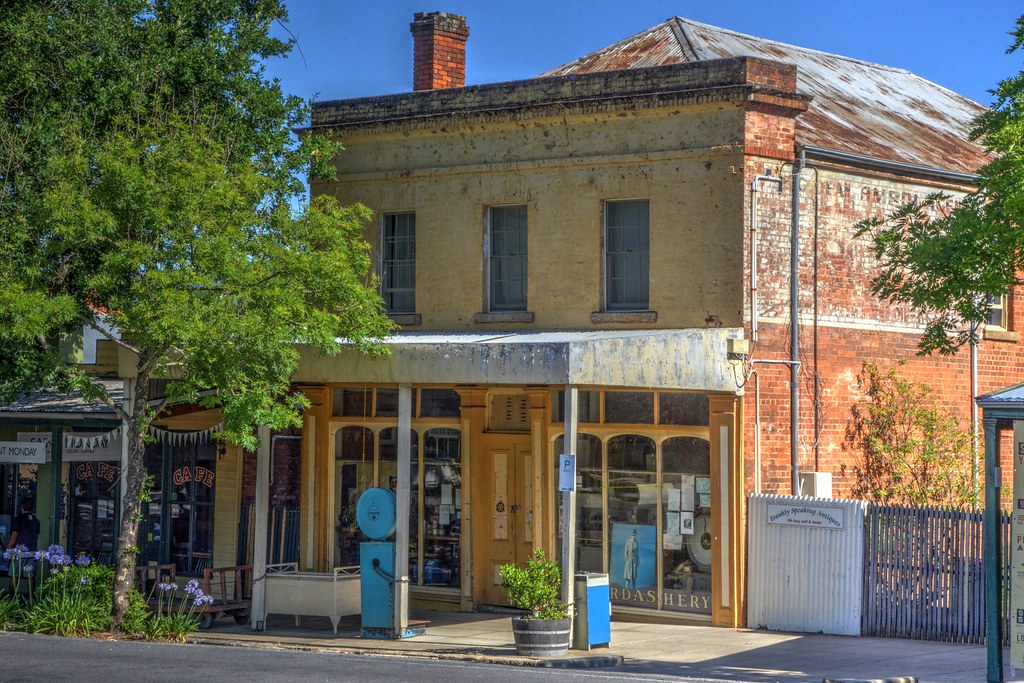
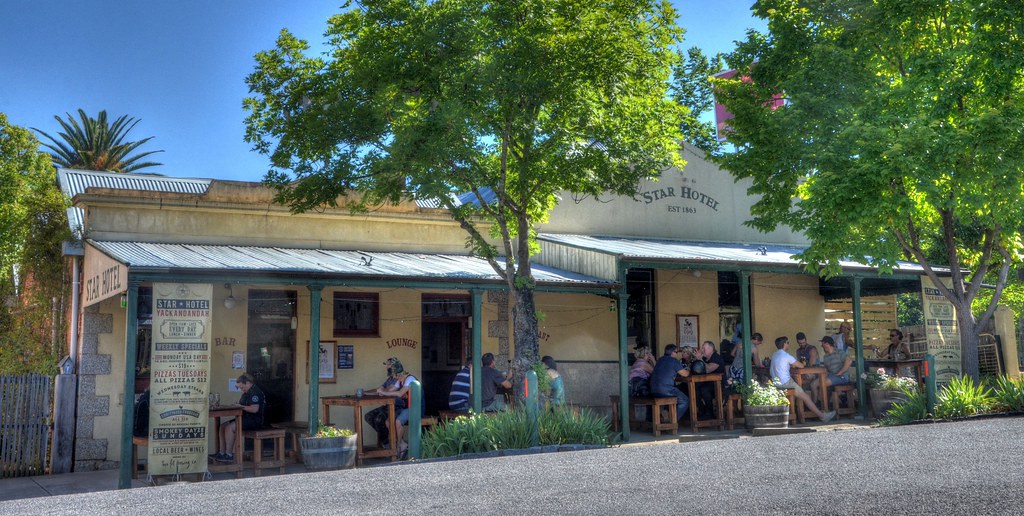






.jpg)








